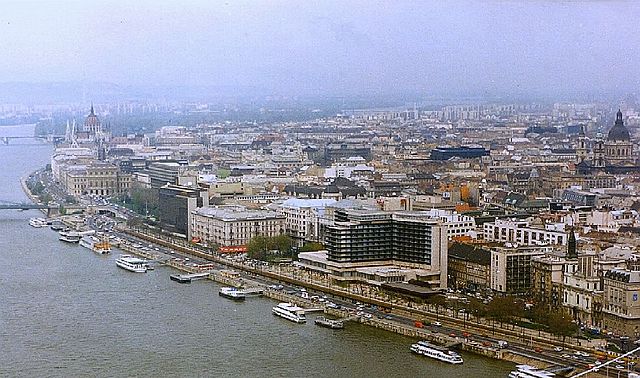Pest, Hungary
Part of Budapest, Hungary From Wikipedia, the free encyclopedia
Pest (Hungarian pronunciation: [ˈpɛʃt]) is the part of Budapest, the capital city of Hungary, that lies on the eastern bank of the Danube. Pest was administratively unified with Buda and Óbuda in 1873; prior to this, it was an independent city. In colloquial Hungarian, "Pest" is sometimes also used pars pro toto to refer to Budapest as a whole.
You can help expand this article with text translated from the corresponding article in Hungarian. (August 2012) Click [show] for important translation instructions.
|


Comprising about two-thirds of the city's area, Pest is flatter and much more heavily urbanized than Buda. Many of Budapest's most notable sites are in Pest, including the Inner City (Hungarian: Belváros), the Parliament (Országház), the Opera, the Great Market Hall, Heroes' Square, and Andrássy Avenue.
Etymology
According to Ptolemy the settlement was called Pession in antiquity (Contra-Aquincum).[citation needed] Alternatively, the name Pest may have come from a Slavic word meaning "furnace", "oven" (Bulgarian пещ [ˈpɛʃt]; Serbian пећ/peć; Croatian peć), related to the word пещера (meaning "cave"), probably with reference to a local cave where fire burned.[1] The spelling Pesth was occasionally used in English, even as late as the early 20th century,[2] although it is now considered archaic.
History



Pest was originally founded as a Celtic settlement, then a fortified camp established by the Romans (Contra-Aquincum) across the river from their military border camp at Aquincum. Remains of the original Roman camp can still be seen at Március 15. tér.
During the Middle Ages, Pest was an independent city separate from Buda/Ofen, which became an important economic center during the 11th–13th centuries. The first written mention dates back to 1148.
Pest was destroyed in 1241 Mongol invasion of Hungary, but was rebuilt shortly thereafter.
Demographically, in the 15th century Pest was mostly Hungarian, while Buda across the Danube had a German-majority population.[4]

In 1838 Pest was flooded by the Danube; parts of the city were under as much as eight feet of water, and the flood destroyed or seriously damaged three-fourths of the city's buildings.[5] In 1849 the first suspension bridge, the Széchenyi Chain Bridge, was constructed across the Danube connecting Pest with Buda. Subsequently, in 1873, the two cities were unified with Óbuda to become Budapest.
Notable people
- László Teleki (1811–1861), writer, statesman and magician
- Henrik Weber (1818–1866), painter
- Theodor Herzl (1860–1904), founder of the political Zionist movement
- Harry Houdini (1874–1926), illusionist and escape acts performer
See also
- Budapest
- Inner City (Budapest)
- Pest County
- Újpest (New Pest)
- Kispest (Little Pest)
- Pestszentlőrinc (Saint Lawrence of Pest)
- Buda
- Óbuda (Old Buda)
References
Further reading
External links
Wikiwand in your browser!
Seamless Wikipedia browsing. On steroids.
Every time you click a link to Wikipedia, Wiktionary or Wikiquote in your browser's search results, it will show the modern Wikiwand interface.
Wikiwand extension is a five stars, simple, with minimum permission required to keep your browsing private, safe and transparent.
